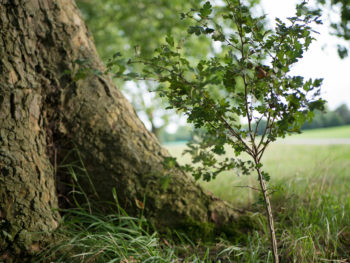
As its first action, Humanist Climate Action is encouraging humanists to plant trees and send a video or photo to us by email or through social media by 6 May. The tree each person plants could be a mighty Oak in an open field or a small Bonsai in a pot. The point is to get as many humanists as possible planting. This will be followed by a formal launch event in May, where HCA will share the videos and photos.
When to plant
The ideal time to plant is either autumn or early spring, for most species. Most trees require a good supply of water, so planting in the summer is not a good idea, especially as the ground may be hard to dig when it is dry. Likewise, the coldest part of the winter may present problems when preparing the ground for planting.
Where to plant
Firstly, make sure that you have the right to plant on the land you have selected. Get in touch with your local authority’s tree officer, sometimes known as the Arboricultural Officer, to get permission to plant a tree on public land such as in a park. Find details on your local authority’s website.
Secondly, think about the location. A sapling or whip may be small now, but it could grow into a very large tree, depending on the species. So think about the surroundings. Are there buildings, paths, or roads that may be disrupted by the growing tree? Also, think about the other vegetation in the location, and whether the mature tree will benefit the area. And think about what will benefit the tree. Windswept locations are unlikely to be the most successful for young trees.
Altitude, climate, water supply, and soil type are all factors that need to be considered when planting a tree. The appropriate species selection is important.
Selecting a tree
Native broadleaf trees are generally the best for planting in the UK, but it will very much depend on the altitude, local climate and soil type. This downloadable guide from the Woodland Trust is very helpful.
Use your judgement, and think about what kind of mature tree would look best in the location you have selected. Then try to imagine future generations enjoying it.
Preparing the ground
Once you have selected your location and tree, you need to prepare the ground for planting. If you are travelling to do the planting, do remember to take the tools you will need and appropriate clothing and footwear.
Measure the diameter of the tree’s root ball, then mark out an area that is four times the width of that diameter and carefully remove the turf, if there is any. Square holes help to prevent roots from growing round in a circle when they meet the change in the soil where you initially dug.
Then dig out the hole, to the same depth as the root ball.
Planting the tree
Mix some organic compost (not peat) with the soil you dug out of the hole, then place the tree in the centre of the hole and return the soil/compost mixture, supporting the tree throughout. Press the soil down firmly around the tree. You may need to put additional soil around the tree’s trunk to support it at first, or even consider a cane or similar support for very young trees.
If your tree is in an area that may be grazed by sheep or wild animals such as deer, then consider putting a protective guard around your tree, preferably not a plastic one. Using a spiral guard will allow the tree to expand as it grows, but you should keep an eye on your tree as it grows and ensure that any guard is not restricting its growth.
More from Humanist Climate Action

Reliable scientific sources on the environment and climate change
Challenging non-evidence based beliefs, misconceptions and disinformation
The environment and the population question
General best practice advice when planting a tree
Urge your MP to stand up for the environment
The background to Humanist Climate Action
